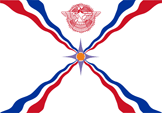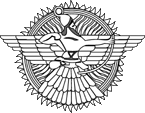mobile View, to the German Version tap the flag


- Assyrians (Eastern Arameans)
- Nation and Christian religious community in the Northern Iraq and Turkey
- own name: Ash-Shuriya
• Flag
• Meaning and Origin of the Symbolism
• Numbers and Facts
• History

National flag,
ratio = 7:10,
Source, by: UNPO,
Wikipedia (D)





The Assyrian Eagle,
Source, by: www.bet-davvid.com

Even at the Eastern Arameans (the so named "Assyrians") the Aramaic eagle arises again but he shows instead of the sun the head of the Old Assyrian god Assur (!), often together with a pale-blue four-pointed star. That star stands symbolic for the Star of Bethlehem and represents the "Spiritual Cross" or even the name of Jesus.
Source und Surftipp: www.oromoye.de

This area is a theoretical construct, a thought, a primeval home, possibly described as a concept by members of this ethnic or religeous group, possibly pursued as a goal by political parties or possibly pursued by armed groups as a goal for an independent state.
Area: ca. 2 300 square miles, im Nordirak und der Türkei
Inhabitants: ca. 800.000
Religions: Nestorianism (chaldaeic church resp. Assyrians), Islam
Languages: Arabian, Aramaïc, Kurdish

The region between the mountains and the district Hikkari Mosul is the original homeland of the Assyrians, with Nineveh as a historical capital. This land later became known and powerful under the name of Mesopotamia. Today Mesopotamia is in Iraq. In the first World War they fought on the Allied side against the Turks. In 1968 was formed the Assyrian Universal Alliance – AUA, a worldwide organization dedicated to the goal of a semi-autonomous state has to fight in the old country. In the course of the 2nd Gulf War in 1991 the situation of the Assyrians became worse. More than 250.000 left Iraq. Military operations in Turkey against the PKK in northern Iraq called for further Assyrian victims. The Assyrians are threatened by inner Kurdish disputes. The AUA and the Assyrian Democratic Movement (Member of the AUA) was able to make to this situation closely. The Assyrians call for the free exercise of their religion and the freedom to use their language. The Assyrian nation covers 3.3 millions Assyrians, including those who have to flee abroad. But the majority of Assyrians lives still in Mesopotamia. Outside of the Middle East approximately 93.000 live in Europe, 300.000 in the U.S. and Canada, 64.000 in Armenia, Georgia and Russia, 33.000 live in Australia and New Zealand, and 150.000 in other countries.
Source: UNPO

The Arameans belonged mostly to the Syrian-Orthodox Church and they are today named also as Syrian christs. They name itself Oromoye (Arameans). The Arameans are divided in two groups: The Eastern Arameans (self-denomination: Ashuroye = Ashurits) and the Western Arameans (self-denomination: Suryoye = Syrer, a word which originally descends from the Greek language). The severance between the Eastern and Western Arameans was made ca. 400 B.C. The in the influence of the Byzantian Empire remained Arameans (Western Arameans) maintained the denomination of Suryoye, while the in the influence of the Persian Empire of the Sassanides comed Arameans (Eastern Arameans) took over the denomination of Ashuroye.
The Western Arameans belonged moreover to the "Syrian-Orthodox Church of Antiochia", while the Eastern Arameans went to the "Holy Syrian-Apostolic Church of the East" (Nestorians resp. Thomas-Christs).
As Europeans roamed through the Middle East (partially in evangelical mission) was the word "Ashuroye" not translated with "Ashurits" but with "Assyrians". In ethnological sight a big mistake. Unfortunately the word "Assyrians" was tooken over and maintained by the Eastern Arameans. In this way is it possible to believe that the Old Assyrians exist until today. Equally name some Western Arameans itself as "Assyrians" and confusions and complete deformations of sense are easily possible.
The Assyrians are even known under the name Thomas-Christs or Nestorians, named according to the apostle Thomas, respectively the patriarch Nestorius (380–451). Nestorius rejected strictly all innovation and modifications in the Christian believe. In this way it came to a break during the conzile of Ephesos (431). Nestorius went to Egypt, and his followers fled in the exile to Persia. The Nestorians reject Greek or Latin as sacral language, and cultivate further the Arameic (Syrian), the mother tongue of Jesus Christ. From Persia the Thomas-Christianity spread out to India and China. On the end of the 14th cent. began the decline and the prosecution of the Nestorians by the Mongolians and Muslims. The leftovers of the communities fled mostly in the trackless Kurdistan, and survived there until today. Those Nestorians, which associate with the Roman church in the course of the 16th cent., are known as Chaldeans, too.
partial source und surf tip: www.oromoye.de,
partial source: Die Völker der Erde


![]()



